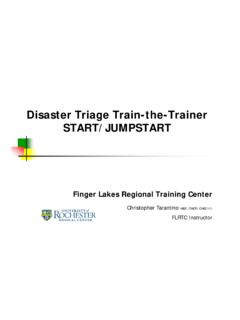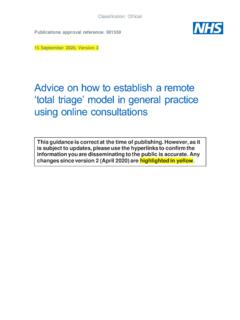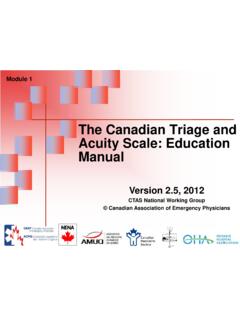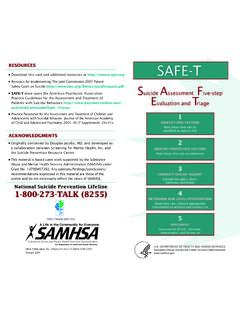Transcription of Mass Casualty, START Triage and the SMART Tag System
1 Mass Casualty, START Triage and the SMART Tag SystemPresented by:QAEMS DepartmentObjectives 1) Define Triage and mass casualty 2) Review the dynamics of START Triage 3) Review use of the SMART tagging System 5) Demonstrate competency in the START Triage method in a variety of scenarios 6) Demonstrate competency in the SMART Triage tag and Casualty Events Given the recent events, we would like to take the opportunity to review the mass casualty Triage System used in the QAEMS System START TRIAGEWhat is a Mass Casualty Incident?
2 ANY event that overwhelmsthe available resources. By available resources, this could mean that we don t have enough ambulances, enough personnel or enough hospital beds. It could be: Natural Accidental or Intentional There A Set Number of Casualties To Be Considered A Mass Casualty or Disaster? No There is no set number associated with declaring a disaster. At times the number of critical patients might impact you more than just overall of Common MCI s Highway Accidents Air Crashes Major Fires Train Derailments Building Collapses Explosions Terrorist Attacks Hazardous Materials Releases Earthquakes Tornadoes Hurricanes FloodsBoston, MA 2013 During the Boston Marathon on April 15, 2013, two pressure cooker bombs exploded at 18:49, killing 3 and injuring 264 people.
3 The bombs exploded about 13 seconds apart and was located 210 yards from each other. They were placed near the finish line on Boylston StreetBoston Marathon Bombing 04/13 Blast The blasts blew out windows on adjacent buildings but did not cause any structural Some runners continued to cross the line until 2:57 EDT, 7 minutesafter the Scene Rescue workers and medical personnel were on hand to assist runners and bystanders rushed to help the wounded in the immediate aftermath. The 264 peopleinjured were treated in 27 local hospitals.
4 At least 14 peoplerequired amputations as a result of the blasts Scene Safety Many people dropped backpacksand other bags as they fled, requiring each to be treated as a potential bomb. A number of news reports stated that more bombs had been found nearby and the Boston Police Bomb Squad said they would perform a controlled explosion on the 600 block of Boylston Street, but in the end no other bombs were found. The Navy sent one of its bomb-disposal units to Boston to help local authorities Communication Limitations?
5 The Massachusetts Emergency Management Agencysuggested people trying to contact those in the vicinity use text messaging, instead of voice calls, because of crowded cell phone lines. Cell phone service in Boston was congested but remained in operation, despite some local media reports stating that cell service was shut down to prevent cell phones from being used as detonators Getting Information Out The American Red Crosshelped concerned friends and family receive information about runners and casualties. The Boston Police Departmentalso set up a helplinefor people concerned about relatives or acquaintances to contact and a line for people to provide information Victim Helps Prevent Other Attacks?
6 Jeff, a victim who lost both legs, was adjacent to the location of one of the bombs. Upon recovering consciousness, he asked for pen and paper and wrote a note to the FBI, "bag, saw the guy, looked right at me". He was later able to provide detailed descriptions to the authorities of a suspect who was seen placing a backpack beside him at the bombing scene two and a half minutes before it exploded, enabling the photo to be identified and circulated quickly Internet s That Easy? During an initial interrogation in the hospital, Dzhokhar said Tamerlan was the mastermind.
7 He said they were motivated by extremist Islamist beliefs and the wars in Iraq and Afghanistan, and that they were self-radicalized and unconnected to any outside terrorist groups, but that they had learned how to build explosive devices from an online magazineof the al-Qaeda affiliate in Trained? He said that he and his brother had decided after the Boston bombings to travel to New York City to bomb Times Square. Dzhokhar was charged on April 22, while still in the hospital, with use of a weapon of mass destructionand malicious destruction of property resulting in death Injury & Treatment A number of the injurieswere grievous, requiring intensive care, and appeared to be "war-like injuries" of mutilation, shrapnel wounds, and dismemberment.
8 The trauma surgerychief at Boston Medical Center said: "We see patients like this, with mangled extremities, but we don't see 16 of them at the same time, and we don't see patients from blast injuriesCan You Hear Me? Doctors described removing "ball-bearing type" metallic beadsa little larger than BBs, and small carpenter-type nails about 1 to centimeters ( to in) long. Similar objects were found at the scene. The New York Timesstated that, according to doctors, because the bombs were low to the ground, the injuries mainly affected legs and feet instead of abdomens, chests, and heads, and as a result few deathsoccurred.
9 Some suffered ruptured eardrumsSystems Are Activated Brigham and Women s Hospital, received thirty-onevictims, twenty-eight of them with significant injuries. Seven arrived nearly at once, starting at 3:08 All required emergency surgery. The first to go to surgery a patient in shock, hemorrhaging profusely, with inadequate breathing and a near-completely severed leg was resuscitated and on an operating table by 3:25 , just thirty-five minutes after the blast. The rest followed, one after the other, spaced by just minutes.
10 Twelve patients in all would undergo surgery mostly vascular and orthopedic procedures before the evening was done. Where Did They All Go? Massachusetts General Hospital also received 31 victims at least four of whom required amputations. Boston Medical Center received 23victims. Beth Israel Deaconess Medical Center handled 21 victims. Boston Children s Hospital took in 10 children, ages two to twelve. Tufts Medical Center and St. Elizabeth s Medical Center each treated 18 What Would You Do? If an explosion, bombing or any event which created a large number of injured and dying people happen while you were on duty: What would you do to care for the injured?







